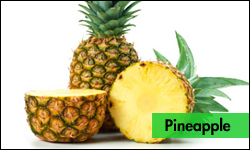Back to > Major Fruits | Minor Fruits | Underutilized Fruits
![]()
 |
|
|
Introduction:
Pineapple is native to Uruguay, Brazil, and Paraguay of South America, a tropical perennial herb with multiple fruit. It is the only common food plant in the Bromeliaceae. It is cultivated commercially in the tropics and parts of the subtropics of the world, with Hawaii producing one-third of the world’s crop. Pineapple from A. comosus var. ananassoides was domesticated by the Tupi-Guarani Indians and accompanied them in their northward migrations to the Antilles, northern Andes and central America before the arrival of the Spanish. Unlike other edible plants from the new world, the pineapple discovered by Europeans in 1493 was quickly accepted by the Europeans. Following the discovery of pineapple, it was soon to be found in various foreign countries either by accident or by intent to introduce the species to a new land and is now grown in various parts of the world, including Australia. Spaniards introduced the pineapple into the Philippines and may have taken it to Hawaii and Guam early in the 16th Century. Portuguese traders are said to have taken seeds to India from the Moluccas in 1548, and they also introduced the pineapple to the east and west coasts of Africa. The plant was growing in China in 1594 and inSouth Africa about 1655. It reached Europe in 1650 and fruits were being produced in Holland in 1686.
Use:
Pineapple is cultivated predominantly for its fruit that is consumed fresh or as canned fruit and juice. Pineapple is the only source of bromelain, a complex proteolytic enzyme used in the pharmaceutical market and as a meat-tenderising agent. The stems and leaves of pineapple plant are also a source of fibre that is white, creamy and lustrous as silk. Pineapple fibre has been processed into paper with remarkable qualities of thinness, smoothness and pliability. Parts of the plant are used for silage and hay for cattle feed. Processing wastes in the form of shell, core materials and centrifuged solids from juice production are also used as animal feed. Alcoholic beverages can also be made from juice.

